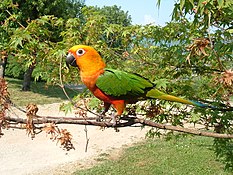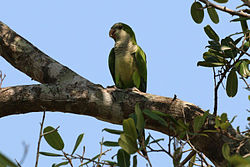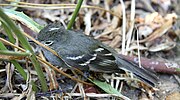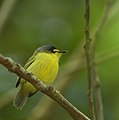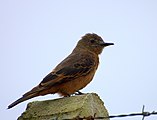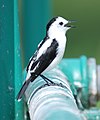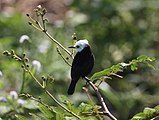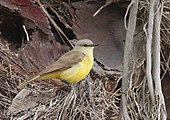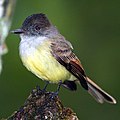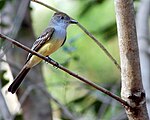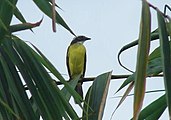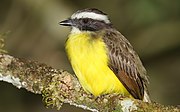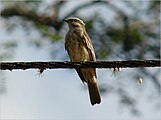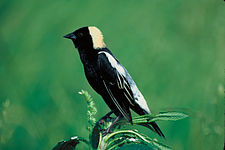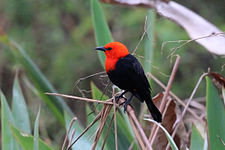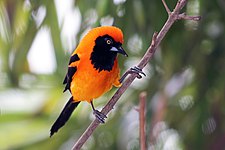User:Elapied/Lab
Cuckoos

Order: Cuculiformes Family: Cuculidae
The family Cuculidae includes cuckoos, roadrunners, and anis. These birds are of variable size with slender bodies, long tails and strong legs.
- Guira cuckoo, Guira guira
- Greater ani, Crotophaga major
- Smooth-billed ani, Crotophaga ani
- Striped cuckoo, Tapera naevia
- Pheasant cuckoo, Dromococcyx phasianellus
- Pavonine cuckoo, Dromococcyx pavoninus
- Rufous-vented ground-cuckoo, Neomorphus geoffroyi
- Scaled ground-cuckoo, Neomorphus squamiger (E) (vulnerable)
- Rufous-winged ground-cuckoo, Neomorphus rufipennis
- Red-billed ground-cuckoo, Neomorphus pucheranii
- Little cuckoo, Coccycua minuta
- Dwarf cuckoo, Coccycua pumila (H)
- Ash-colored cuckoo, Coccycua cinerea
- Squirrel cuckoo, Piaya cayana
- Black-bellied cuckoo, Piaya melanogaster
- Dark-billed cuckoo, Coccyzus melacoryphus
- Yellow-billed cuckoo, Coccyzus americanus
- Pearly-breasted cuckoo, Coccyzus euleri
- Mangrove cuckoo, Coccyzus minor
- Black-billed cuckoo, Coccyzus erythropthalmus (V)
Trogons

Order: Trogoniformes Family: Trogonidae
The family Trogonidae includes trogons and quetzals. Found in tropical woodlands worldwide, they feed on insects and fruit, and their broad bills and weak legs reflect their diet and arboreal habits. Although their flight is fast, they are reluctant to fly any distance. Trogons have soft, often colorful, feathers with distinctive male and female plumage.
- Pavonine quetzal, Pharomachrus pavoninus
- Black-tailed trogon, Trogon melanurus
- Green-backed trogon, Trogon viridis
- Amazonian trogon, Trogon ramonianus
- Guianan trogon, Trogon violaceus
- Blue-crowned trogon, Trogon curucui
- Surucua trogon, Trogon surrucura
- Black-throated trogon, Trogon rufus
- Collared trogon, Trogon collaris
- Masked trogon, Trogon personatus
Puffbirds

Order: Galbuliformes Family: Bucconidae
The puffbirds are related to the jacamars and have the same range, but lack the iridescent colors of that family. They are mainly brown, rufous, or gray, with large heads and flattened bills with hooked tips. The loose abundant plumage and short tails makes them look stout and puffy, giving rise to the English common name of the family.
- White-necked puffbird, Notharchus hyperrhynchus
- Guianan puffbird, Notharchus macrorhynchos
- Buff-bellied puffbird, Notharchus swainsoni
- Brown-banded puffbird, Notharchus ordii
- Pied puffbird, Notharchus tectus
- Chestnut-capped puffbird, Bucco macrodactylus
- Spotted puffbird, Bucco tamatia
- Collared puffbird, Bucco capensis
- Western striolated-puffbird, Nystalus obamai
- Eastern striolated-puffbird, Nystalus striolatus
- White-eared puffbird, Nystalus chacuru
- Spot-backed puffbird, Nystalus maculatus
- White-chested puffbird, Malacoptila fusca
- Semicollared puffbird, Malacoptila semicincta
- Crescent-chested puffbird, Malacoptila striata (E)
- Rufous-necked puffbird, Malacoptila rufa
- Lanceolated monklet, Micromonacha lanceolata
- Rusty-breasted nunlet, Nonnula rubecula
- Fulvous-chinned nunlet, Nonnula sclateri
- Rufous-capped nunlet, Nonnula ruficapilla
- Chestnut-headed nunlet, Nonnula amaurocephala (E)
- Black nunbird, Monasa atra
- Black-fronted nunbird, Monasa nigrifrons
- White-fronted nunbird, Monasa morphoeus
- Yellow-billed nunbird, Monasa flavirostris
- Swallow-winged puffbird, Chelidoptera tenebrosa
New World barbets
Order: Piciformes Family: Capitonidae
The barbets are plump birds, with short necks and large heads. They get their name from the bristles which fringe their heavy bills. Most species are brightly colored.
- Scarlet-crowned barbet, Capito aurovirens
- Black-girdled barbet, Capito dayi
- Brown-chested barbet, Capito brunneipectus (E)
- Black-spotted barbet, Capito niger
- Gilded barbet, Capito auratus
- Lemon-throated barbet, Eubucco richardsoni
- Scarlet-hooded barbet, Eubucco tucinkae
Woodpeckers



Order: Piciformes Family: Picidae
Woodpeckers are small to medium-sized birds with chisel-like beaks, short legs, stiff tails, and long tongues used for capturing insects. Some species have feet with two toes pointing forward and two backward, while several species have only three toes. Many woodpeckers have the habit of tapping noisily on tree trunks with their beaks.
- Bar-breasted piculet, Picumnus aurifrons
- Orinoco piculet, Picumnus pumilus
- Lafresnaye's piculet, Picumnus lafresnayi
- Golden-spangled piculet, Picumnus exilis
- White-bellied piculet, Picumnus spilogaster
- Ochraceous piculet, Picumnus limae (E)
- Spotted piculet, Picumnus pygmaeus (E)
- Varzea piculet, Picumnus varzeae (E)
- White-barred piculet, Picumnus cirratus
- Ochre-collared piculet, Picumnus temminckii
- White-wedged piculet, Picumnus albosquamatus
- Rusty-necked piculet, Picumnus fuscus
- Rufous-breasted piculet, Picumnus rufiventristhreatened)
- Mottled piculet, Picumnus nebulosus (near-threatened)
- Plain-breasted piculet, Picumnus castelnau
- Fine-barred piculet, Picumnus subtilis
- White woodpecker, Melanerpes candidus
- Yellow-tufted woodpecker, Melanerpes cruentatus
- Yellow-fronted woodpecker, Melanerpes flavifrons
- White-fronted woodpecker, Melanerpes cactorum
- Red-rumped woodpecker, Dryobates kirkii
- Golden-collared woodpecker, Dryobates cassini
- White-spotted woodpecker, Dryobates spilogaster
- Checkered woodpecker, Dryobates mixtus
- Little woodpecker, Dryobates passerinus
- Red-stained woodpecker, Dryobates affinis
- Yellow-eared woodpecker, Dryobates maculifrons (E)
- Red-necked woodpecker, Campephilus rubricollis
- Robust woodpecker, Campephilus robustus
- Crimson-crested woodpecker, Campephilus melanoleucos
- Cream-backed woodpecker, Campephilus leucopogon
- Lineated woodpecker, Dryocopus lineatus
- Ringed woodpecker, Celeus torquatus
- Helmeted woodpecker, Celeus galeatus (vulnerable)
- Scale-breasted woodpecker, Celeus grammicus
- Waved woodpecker, Celeus undatus
- Cream-colored woodpecker, Celeus flavus
- Rufous-headed woodpecker, Celeus spectabilis
- Kaempfer's woodpecker, Celeus obrieni (E)
- Ochre-backed woodpecker, Celeus ochraceus (E)
- Chestnut woodpecker, Celeus elegans
- Pale-crested woodpecker, Celeus lugubris
- Blond-crested woodpecker, Celeus flavescens
- White-throated woodpecker, Piculus leucolaemus
- Yellow-throated woodpecker, Piculus flavigula
- Golden-green woodpecker, Piculus chrysochloros
- White-browed woodpecker, Piculus aurulentus (near-threatened)
- Golden-olive woodpecker, Colaptes rubiginosus
- Spot-breasted woodpecker, Colaptes punctigula
- Green-barred woodpecker, Colaptes melanochloros
- Campo flicker, Colaptes campestris
Seriemas

Order: Cariamiformes Family: Cariamidae
The seriemas are terrestrial birds which run rather than fly (though they are able to fly for short distances). They have long legs, necks and tails, but only short wings, reflecting their way of life. They are brownish birds with short bills and erectile crests, found on fairly-dry open grasslands.
- Red-legged seriema, Cariama cristata
Falcons


Order: Falconiformes Family: Falconidae
Falconidae is a family of diurnal birds of prey. They differ from hawks, eagles and kites in that they kill with their beaks instead of their talons.
- Laughing falcon, Herpetotheres cachinnans
- Barred forest-falcon, Micrastur ruficollis
- Lined forest-falcon, Micrastur gilvicollis
- Cryptic forest-falcon, Micrastur mintoni
- Slaty-backed forest-falcon, Micrastur mirandollei
- Collared forest-falcon, Micrastur semitorquatus
- Buckley's forest-falcon, Micrastur buckleyi
- Crested caracara, Caracara cheriway
- Southern caracara, Caracara plancus
- Red-throated caracara, Ibycter americanus
- Black caracara, Daptrius ater
- Yellow-headed caracara, Milvago chimachima
- Chimango caracara, Milvago chimango
- Eurasian kestrel, Falco tinnunculus (V)
- American kestrel, Falco sparverius
- Merlin, Falco columbarius (V)
- Bat falcon, Falco rufigularis
- Orange-breasted falcon, Falco deiroleucus
- Aplomado falcon, Falco femoralis
- Peregrine falcon, Falco peregrinus
New World and African parrots
Order: Psittaciformes Family: Psittacidae
Parrots are small to large birds with a characteristic curved beak. Their upper mandibles have slight mobility in the joint with the skull and they have a generally erect stance. All parrots are zygodactyl, having the four toes on each foot placed two at the front and two to the back.
- Scarlet-shouldered parrotlet, Touit huetii
- Sapphire-rumped parrotlet, Touit purpuratus
- Brown-backed parrotlet, Touit melanonotus (E) (vulnerable)
- Golden-tailed parrotlet, Touit surdus (E) (vulnerable)
- Tepui parrotlet, Nannopsittaca panychlora
- Amazonian parrotlet, Nannopsittaca dachilleae
- Monk parakeet, Myiopsitta monachus
- Tui parakeet, Brotogeris sanctithomae
- Plain parakeet, Brotogeris tirica (E)
- Canary-winged parakeet, Brotogeris versicolurus
- Yellow-chevroned parakeet, Brotogeris chiriri
- Cobalt-winged parakeet, Brotogeris cyanoptera
- Golden-winged parakeet, Brotogeris chrysoptera
- Pileated parrot, Pionopsitta pileata
- Blue-bellied parrot, Triclaria malachitacea (E) (near-threatened)
- Orange-cheeked parrot, Pyrilia barrabandi
- Caica parrot, Pyrilia caica
- Bald parrot, Pyrilia aurantiocephala (E)
- Vulturine parrot, Pyrilia vulturina (E)
- Dusky parrot, Pionus fuscus
- Scaly-headed parrot, Pionus maximiliani
- Blue-headed parrot, Pionus menstruus
- Short-tailed parrot, Graydidascalus brachyurus
- Yellow-faced parrot, Alipiopsitta xanthops (near-threatened)
- Festive parrot, Amazona festiva
- Vinaceous-breasted parrot, Amazona vinacea (endangered)
- Red-spectacled parrot, Amazona pretrei (E) (vulnerable)
- Red-lored parrot, Amazona autumnalis
- Blue-cheeked parrot, Amazona dufresniana (near-threatened)
- Red-browed parrot, Amazona rhodocorytha (E) (vulnerable)
- Yellow-crowned parrot, Amazona ochrocephala
- Turquoise-fronted parrot, Amazona aestiva
- Mealy parrot, Amazona farinosa
- Kawall's parrot, Amazona kawalli (E)
- Red-tailed parrot, Amazona brasiliensis (E) (near-threatened)
- Orange-winged parrot, Amazona amazonica
- Dusky-billed parrotlet, Forpus modestus
- Blue-winged parrotlet, Forpus xanthopterygius
- Green-rumped parrotlet, Forpus passerinus
- Black-headed parrot, Pionites melanocephalus
- White-bellied parrot, Pionites leucogaster
- Red-fan parrot, Deroptyus accipitrinus
- Ochre-marked parakeet, Pyrrhura cruentata (E) (vulnerable)
- Blaze-winged parakeet, Pyrrhura devillei
- Maroon-bellied parakeet, Pyrrhura frontalis
- Pearly parakeet, Pyrrhura lepida (E) (vulnerable)
- Crimson-bellied parakeet, Pyrrhura perlata
- Green-cheeked parakeet, Pyrrhura molinae
- Pfrimer's parakeet, Pyrrhura pfrimeri (E)
- Gray-breasted parakeet, Pyrrhura griseipectus (E)
- Maroon-faced parakeet, Pyrrhura leucotis (E)
- Painted parakeet, Pyrrhura picta
- Santarem parakeet, Pyrrhura amazonum
- Bonaparte's parakeet, Pyrrhura lucianii
- Rose-fronted parakeet, Pyrrhura roseifrons
- Fiery-shouldered parakeet, Pyrrhura egregia
- Maroon-tailed parakeet, Pyrrhura melanura
- Black-capped parakeet, Pyrrhura rupicola
- Hyacinth macaw, Anodorhynchus hyacinthinus (vulnerable)
- Glaucous macaw, Anodorhynchus glaucus (critically endangered, believed extinct)
- Indigo macaw, Anodorhynchus leari (E) (endangered)
- Peach-fronted parakeet, Eupsittula aurea
- Brown-throated parakeet, Eupsittula pertinax
- Cactus parakeet, Eupsittula cactorum (E)
- Dusky-headed parakeet, Aratinga weddellii
- Nanday parakeet, Aratinga nenday
- Sun parakeet, Aratinga solstitialis
- Sulphur-breasted parakeet, Aratinga maculata
- Jandaya parakeet, Aratinga jandaya (E)
- Golden-capped parakeet, Aratinga auricapillus (E)
- Spix's macaw, Cyanopsitta spixii (E) (extinct in the wild)
- Red-bellied macaw, Orthopsittaca manilatus
- Blue-winged macaw, Primolius maracana (near-threatened)
- Blue-headed macaw, Primolius couloni
- Yellow-collared macaw, Primolius auricollis
- Blue-and-yellow macaw, Ara ararauna
- Scarlet macaw, Ara macao
- Red-and-green macaw, Ara chloropterus
- Chestnut-fronted macaw, Ara severus
- Golden parakeet, Guaruba guarouba (E) (vulnerable)
- Blue-crowned parakeet, Thectocercus acuticaudatus
- Red-shouldered macaw, Diopsittaca nobilis
- White-eyed parakeet, Psittacara leucophthalmus
-
Hyacinth macaw
-
Red-and-green macaws
-
Jandaya parakeet
-
Turquoise-fronted parrot
-
Maroon-bellied parakeet
-
Monk parakeet
-
Yellow-faced parrot
Antbirds



Order: Passeriformes Family: Thamnophilidae
The antbirds are a large family of small passerine birds of subtropical and tropical Central and South America. They are forest birds which tend to feed on insects at or near the ground. A sizable minority of them specialize in following columns of army ants to eat small invertebrates that leave their hiding places to flee from the ants. Many species lack bright color, with brown, black, and white being the dominant tones.
- Chestnut-shouldered antwren, Euchrepomis humeralis
- Ash-winged antwren, Euchrepomis spodioptila
- Fasciated antshrike, Cymbilaimus lineatus
- Bamboo antshrike, Cymbilaimus sanctaemariae
- Spot-backed antshrike, Hypoedaleus guttatus
- Giant antshrike, Batara cinerea
- Large-tailed antshrike, Mackenziaena leachii
- Tufted antshrike, Mackenziaena severa
- Black-throated antshrike, Frederickena viridis
- Undulated antshrike, Frederickena unduliger
- Great antshrike, Taraba major
- Black-crested antshrike, Sakesphorus canadensis
- Silvery-cheeked antshrike, Sakesphorus cristatus (E)
- Glossy antshrike, Sakesphorus luctuosus (E)
- White-bearded antshrike, Biatas nigropectus (vulnerable)
- Barred antshrike, Thamnophilus doliatus
- Rufous-capped antshrike, Thamnophilus ruficapillus
- Rufous-winged antshrike, Thamnophilus torquatus
- Chestnut-backed antshrike, Thamnophilus palliatus
- Plain-winged antshrike, Thamnophilus schistaceus
- Mouse-colored antshrike, Thamnophilus murinus
- Castelnau's antshrike, Thamnophilus cryptoleucus
- Blackish-gray antshrike, Thamnophilus nigrocinereus
- Northern slaty-antshrike, Thamnophilus punctatus
- Natterer's slaty-antshrike, Thamnophilus stictocephalus
- Bolivian slaty-antshrike, Thamnophilus sticturus
- Planalto slaty-antshrike, Thamnophilus pelzelni (E)
- Sooretama slaty-antshrike, Thamnophilus ambiguus (E)
- Variable antshrike, Thamnophilus caerulescens
- White-shouldered antshrike, Thamnophilus aethiops
- Band-tailed antshrike, Thamnophilus melanothorax
- Amazonian antshrike, Thamnophilus amazonicus
- Streak-backed antshrike, Thamnophilus insignis
- Acre antshrike, Thamnophilus divisorius
- Star-throated antwren, Rhopias gularis (E)
- Pearly antshrike, Megastictus margaritatus
- Black bushbird, Neoctantes niger
- Rondonia bushbird, Clytoctantes atrogularis (E) (vulnerable)
- Spot-breasted antvireo, Dysithamnus stictothorax (E) (near-threatened)
- Plain antvireo, Dysithamnus mentalis
- Rufous-backed antvireo, Dysithamnus xanthopterus (E)
- Plumbeous antvireo, Dysithamnus plumbeus (E) (vulnerable)
- Dusky-throated antshrike, Thamnomanes ardesiacus
- Saturnine antshrike, Thamnomanes saturninus
- Cinereous antshrike, Thamnomanes caesius
- Bluish-slate antshrike, Thamnomanes schistogynus
- Plain-throated antwren, Isleria hauxwelli
- Rufous-bellied antwren, Isleria guttata
- Spot-winged antshrike, Pygiptila stellaris
- Brown-bellied stipplethroat, Epinecrophylla gutturalis
- White-eyed stipplethroat, Epinecrophylla leucophthalma
- Rufous-backed stipplethroat, Epinecrophylla haematonota
- Rio Madeira stipplethroat, Epinecrophylla amazonica
- Ornate stipplethroat, Epinecrophylla ornata
- Rufous-tailed stipplethroat, Epinecrophylla erythrura
- Pygmy antwren, Myrmotherula brachyura
- Moustached antwren, Myrmotherula ignota
- Yellow-throated antwren, Myrmotherula ambigua
- Sclater's antwren, Myrmotherula sclateri
- Guianan streaked-antwren, Myrmotherula surinamensis
- Amazonian streaked-antwren, Myrmotherula multostriata
- Cherrie's antwren, Myrmotherula cherriei
- Klages's antwren, Myrmotherula klagesi (E) (vulnerable)
- White-flanked antwren, Myrmotherula axillaris
- Rio Suno antwren, Myrmotherula sunensis
- Salvadori's antwren, Myrmotherula minor (E) (vulnerable)
- Long-winged antwren, Myrmotherula longipennis
- Band-tailed antwren, Myrmotherula urosticta (E) (vulnerable)
- Ihering's antwren, Myrmotherula iheringi
- Rio de Janeiro antwren, Myrmotherula fluminensis (E) (not yet assessed by IUCN)
- Unicolored antwren, Myrmotherula unicolor (E)
- Alagoas antwren, Myrmotherula snowi (E) (critically endangered)
- Plain-winged antwren, Myrmotherula behni
- Gray antwren, Myrmotherula menetriesii
- Leaden antwren, Myrmotherula assimilis
- Banded antbird, Dichrozona cincta
- Stripe-backed antbird, Myrmorchilus strigilatus
- Caatinga antwren, Herpsilochmus sellowi (E)
- Predicted antwren, Herpsilochmus praedictus (E)
- Aripuana antwren, Herpsilochmus stotzi (E)
- Black-capped antwren, Herpsilochmus atricapillus
- Bahia antwren, Herpsilochmus pileatus (E) (vulnerable)
- Spot-tailed antwren, Herpsilochmus sticturus
- Todd's antwren, Herpsilochmus stictocephalus
- Spot-backed antwren, Herpsilochmus dorsimaculatus
- Roraiman antwren, Herpsilochmus roraimae
- Pectoral antwren, Herpsilochmus pectoralis (E) (vulnerable)
- Large-billed antwren, Herpsilochmus longirostris
- Rufous-winged antwren, Herpsilochmus rufimarginatus (see note)[note 1]
- Dot-winged antwren, Microrhopias quixensis
- Narrow-billed antwren, Formicivora iheringi (E) (near-threatened)
- Black-hooded antwren, Formicivora erythronotos (E) (endangered)
- White-fringed antwren, Formicivora grisea
- Serra antwren, Formicivora serrana (E)
- Restinga antwren, Formicivora littoralis (E) (not yet assessed by IUCN)
- Black-bellied antwren, Formicivora melanogaster
- Rusty-backed antwren, Formicivora rufa
- Sincora antwren, Formicivora grantsaui (E) (endangered)
- Parana antwren, Stymphalornis acutirostris (E) (endangered)
- Ferruginous antbird, Drymophila ferruginea (E)
- Bertoni's antbird, Drymophila rubricollis
- Rufous-tailed antbird, Drymophila genei (E)
- Ochre-rumped antbird, Drymophila ochropyga (E) (near-threatened)
- Dusky-tailed antbird, Drymophila malura
- Scaled antbird, Drymophila squamata (E)
- Striated antbird, Drymophila devillei
- Guianan warbling-antbird, Hypocnemis cantator
- Imeri warbling-antbird, Hypocnemis flavescens
- Peruvian warbling-antbird, Hypocnemis peruviana
- Yellow-breasted warbling-antbird, Hypocnemis subflava
- Manicore warbling-antbird, Hypocnemis rondoni (E)
- Rondonia warbling-antbird, Hypocnemis ochrogyna
- Spix's warbling-antbird, Hypocnemis striata (E)
- Yellow-browed antbird, Hypocnemis hypoxantha
- Orange-bellied antwren, Terenura sicki (E) (critically endangered)
- Streak-capped antwren, Terenura maculata
- Willis's antbird, Cercomacroides laeta
- Dusky antbird, Cercomacroides tyrannina
- Black antbird, Cercomacroides serva
- Blackish antbird, Cercomacroides nigrescens
- Riparian antbird, Cercomacroides fuscicauda
- Manu antbird, Cercomacra manu
- Gray antbird, Cercomacra cinerascens
- Rio de Janeiro antbird, Cercomacra brasiliana (E) (near-threatened)
- Mato Grosso antbird, Cercomacra melanaria
- Bananal antbird, Cercomacra ferdinandi (E)
- Rio Branco antbird, Cercomacra carbonaria (critically endangered)
- Western fire-eye, Pyriglena maura
- Tapajos fire-eye, Pyriglena similis (E)
- East Amazonian fire-eye, Pyriglena leuconota (E)
- Fringe-backed fire-eye, Pyriglena atra (E) (endangered)
- White-shouldered fire-eye, Pyriglena leucoptera
- Slender antbird, Rhopornis ardesiacus (E) (endangered)
- White-browed antbird, Myrmoborus leucophrys
- Ash-breasted antbird, Myrmoborus lugubris
- Black-faced antbird, Myrmoborus myotherinus
- Black-tailed antbird, Myrmoborus melanurus (vulnerable)
- White-lined antbird, Myrmoborus lophotes
- Black-chinned antbird, Hypocnemoides melanopogon
- Band-tailed antbird, Hypocnemoides maculicauda
- Black-and-white antbird, Myrmochanes hemileucus
- Silvered antbird, Sclateria naevia
- Black-headed antbird, Percnostola rufifrons
- Slate-colored antbird, Myrmelastes schistaceus
- Roraiman antbird, Myrmelastes saturatus
- Plumbeous antbird, Myrmelastes hyperythrus
- Spot-winged antbird, Myrmelastes leucostigma
- Humaita antbird, Myrmelastes humaythae
- Rufous-faced antbird, Myrmelastes rufifacies (E)
- Caura antbird, Myrmelastes caurensis
- White-bellied antbird, Myrmeciza longipes
- Chestnut-tailed antbird, Sciaphylax hemimelaena
- Ferruginous-backed antbird, Myrmoderus ferrugineus
- Scalloped antbird, Myrmoderus ruficauda (E) (endangered)
- White-bibbed antbird, Myrmoderus loricatus (E)
- Squamate antbird, Myrmoderus squamosus (E)
- White-shouldered antbird, Akletos melanoceps
- Goeldi's antbird, Akletos goeldii
- Sooty antbird, Hafferia fortis
- Yapacana antbird, Aprositornis disjuncta
- Black-throated antbird, Myrmophylax atrothorax
- Gray-bellied antbird, Ammonastes pelzelni
- Wing-banded antbird, Myrmornis torquata
- White-plumed antbird, Pithys albifrons
- White-cheeked antbird, Gymnopithys leucaspis
- Rufous-throated antbird, Gymnopithys rufigula
- White-throated antbird, Oncillornis salvini
- Bare-eyed antbird, Rhegmatorhina gymnops (E)
- Harlequin antbird, Rhegmatorhina berlepschi (E)
- White-breasted antbird, Rhegmatorhina hoffmannsi (E)
- Chestnut-crested antbird, Rhegmatorhina cristata
- Hairy-crested antbird, Rhegmatorhina melanosticta
- Spot-backed antbird, Hylophylax naevius
- Dot-backed antbird, Hylophylax punctulatus
- Common scale-backed antbird, Willisornis poecilinotus
- Xingu scale-backed antbird, Willisornis vidua (E)
- Black-spotted bare-eye, Phlegopsis nigromaculata
- Reddish-winged bare-eye, Phlegopsis erythroptera
- Pale-faced bare-eye, Phlegopsis borbae (E)
Crescentchests
Order: Passeriformes Family: Melanopareiidae
These are smallish birds which inhabit regions of arid scrub. They have a band across the chest which gives them their name.
- Collared crescentchest, Melanopareia torquata
Gnateaters

Order: Passeriformes Family: Conopophagidae
The gnateaters are round, short-tailed and long-legged birds, which are closely related to the antbirds.
- Black-bellied gnateater, Conopophaga melanogaster (E)
- Black-cheeked gnateater, Conopophaga melanops (E)
- Chestnut-belted gnateater, Conopophaga aurita
- Ash-throated gnateater, Conopophaga peruviana
- Ceara gnateater, Conopophaga cearae (E)
- Hooded gnateater, Conopophaga roberti (E)
- Rufous gnateater, Conopophaga lineata
Antpittas
Order: Passeriformes Family: Grallariidae
Antpittas resemble the true pittas with strong, longish legs, very short tails and stout bills.
- Variegated antpitta, Grallaria varia
- Elusive antpitta, Grallaria eludens
- Speckle-breasted antpitta, Cryptopezus nattereri
- White-browed antpitta, Hylopezus ochroleucus (E) (near-threatened)
- Spotted antpitta, Hylopezus macularius
- Alta Floresta antpitta, Hylopezus whittakeri (E)
- Snethlage's antpitta, Hylopezus paraensis (E)
- Amazonian antpitta, Myrmothera berlepschi
- Thrush-like antpitta, Myrmothera campanisona
- Tepui antpitta, Myrmothera simplex
- Tapajos antpitta, Myrmothera subcanescens (E)
Tapaculos
Order: Passeriformes Family: Rhinocryptidae
The tapaculos are small suboscine passeriform birds with numerous species in South and Central America. They are terrestrial species that fly only poorly on their short wings. They have strong legs, well-suited to their habitat of grassland or forest undergrowth. The tail is cocked and pointed towards the head.
- Spotted bamboowren, Psilorhamphus guttatus (near-threatened)
- Rusty-belted tapaculo, Liosceles thoracicus
- Slaty bristlefront, Merulaxis ater (E) (near-threatened)
- Stresemann's bristlefront, Merulaxis stresemanni (E) (critically endangered)
- Bahia tapaculo, Eleoscytalopus psychopompus (E) (endangered)
- White-breasted tapaculo, Eleoscytalopus indigoticus (E) (near-threatened)
- Boa Nova tapaculo, Scytalopus gonzagai (E)
- Mouse-colored tapaculo, Scytalopus speluncae (E)
- Diamantina tapaculo, Scytalopus diamantinensis (E)
- Rock tapaculo, Scytalopus petrophilus (E)
- Planalto tapaculo, Scytalopus pachecoi
- Marsh tapaculo, Scytalopus iraiensis (E) (endangered)
- Brasilia tapaculo, Scytalopus novacapitalis (E) (near-threatened)
Antthrushes
Order: Passeriformes Family: Formicariidae
Antthrushes resemble small rails.
- Rufous-capped antthrush, Formicarius colma
- Black-faced antthrush, Formicarius analis
- Rufous-fronted antthrush, Formicarius rufifrons
- Short-tailed antthrush, Chamaeza campanisona
- Striated antthrush, Chamaeza nobilis
- Such's antthrush, Chamaeza meruloides (E)
- Rufous-tailed antthrush, Chamaeza ruficauda
Ovenbirds








Order: Passeriformes Family: Furnariidae
Ovenbirds comprise a large family of small sub-oscine passerine bird species found in Central and South America. They are a diverse group of insectivores which gets its name from the elaborate "oven-like" clay nests built by some species, although others build stick nests or nest in tunnels or clefts in rock. The woodcreepers are brownish birds which maintain an upright vertical posture, supported by their stiff tail vanes. They feed mainly on insects taken from tree trunks.
- South American leaftosser, Sclerurus obscurior
- Short-billed leaftosser, Sclerurus rufigularis
- Black-tailed leaftosser, Sclerurus caudacutus
- Gray-throated leaftosser, Sclerurus albigularis
- Rufous-breasted leaftosser, Sclerurus scansor
- Common miner, Geositta cunicularia
- Campo miner, Geositta poeciloptera (near-threatened)
- Spot-throated woodcreeper, Certhiasomus stictolaemus
- Olivaceous woodcreeper, Sittasomus griseicapillus
- Long-tailed woodcreeper, Deconychura longicauda
- White-chinned woodcreeper, Dendrocincla merula
- Plain-brown woodcreeper, Dendrocincla fuliginosa
- Plain-winged woodcreeper, Dendrocincla turdina
- Wedge-billed woodcreeper, Glyphorynchus spirurus
- Cinnamon-throated woodcreeper, Dendrexetastes rufigula
- Long-billed woodcreeper, Nasica longirostris
- Amazonian barred-woodcreeper, Dendrocolaptes certhia
- Black-banded woodcreeper, Dendrocolaptes picumnus
- Hoffmanns's woodcreeper, Dendrocolaptes hoffmannsi (E)
- Planalto woodcreeper, Dendrocolaptes platyrostris
- Bar-bellied woodcreeper, Hylexetastes stresemanni
- Red-billed woodcreeper, Hylexetastes perrotii
- Strong-billed woodcreeper, Xiphocolaptes promeropirhynchus
- Moustached woodcreeper, Xiphocolaptes falcirostris (E) (vulnerable)
- White-throated woodcreeper, Xiphocolaptes albicollis
- Great rufous woodcreeper, Xiphocolaptes major
- Striped woodcreeper, Xiphorhynchus obsoletus
- Lesser woodcreeper, Xiphorhynchus fuscus (see note)[note 2]
- Chestnut-rumped woodcreeper, Xiphorhynchus pardalotus
- Ocellated woodcreeper, Xiphorhynchus ocellatus
- Elegant woodcreeper, Xiphorhynchus elegans
- Spix's woodcreeper, Xiphorhynchus spixii (E)
- Buff-throated woodcreeper, Xiphorhynchus guttatus
- Straight-billed woodcreeper, Dendroplex picus
- Zimmer's woodcreeper, Dendroplex kienerii
- Red-billed scythebill, Campylorhamphus trochilirostris
- Black-billed scythebill, Campylorhamphus falcularius
- Curve-billed scythebill, Campylorhamphus procurvoides
- Scimitar-billed woodcreeper, Drymornis bridgesii
- Streak-headed woodcreeper, Lepidocolaptes souleyetii
- Narrow-billed woodcreeper, Lepidocolaptes angustirostris
- Scaled woodcreeper, Lepidocolaptes squamatus (E)
- Scalloped woodcreeper, Lepidocolaptes falcinellus
- Duida woodcreeper, Lepidocolaptes duidae
- Guianan woodcreeper, Lepidocolaptes albolineatus
- Inambari woodcreeper, Lepidocolaptes fatimalimae
- Rondonia woodcreeper, Lepidocolaptes fuscicapillus
- Layard's woodcreeper, Lepidocolaptes layardi (E)
- Slender-billed xenops, Xenops tenuirostris
- Plain xenops, Xenops minutus
- Streaked xenops, Xenops rutilans
- Point-tailed palmcreeper, Berlepschia rikeri
- Rufous-tailed xenops, Microxenops milleri
- Chaco earthcreeper, Tarphonomus certhioides (V)
- Wing-banded hornero, Furnarius figulus (E)
- Pale-legged hornero, Furnarius leucopus
- Pale-billed hornero, Furnarius torridus
- Lesser hornero, Furnarius minor
- Rufous hornero, Furnarius rufus
- Sharp-tailed streamcreeper, Lochmias nematura
- Wren-like rushbird, Phleocryptes melanops
- Curve-billed reedhaunter, Limnornis curvirostris
- Long-tailed cinclodes, Cinclodes pabsti (E)
- Buff-winged cinclodes, Cinclodes fuscus
- Dusky-cheeked foliage-gleaner, Anabazenops dorsalis
- White-collared foliage-gleaner, Anabazenops fuscus (E)
- Great xenops, Megaxenops parnaguae (E)
- Pale-browed treehunter, Cichlocolaptes leucophrus (E)
- Cryptic treehunter, Cichlocolaptes mazarbarnetti (E) (critically endangered) (First described in 2014. Not evaluated by the SACC; a proposal is pending. Not included in counts.)[1][2]
- Sharp-billed treehunter, Heliobletus contaminatus
- Rufous-rumped foliage-gleaner, Philydor erythrocercum
- Alagoas foliage-gleaner, Philydor novaesi (E) (critically endangered)
- Black-capped foliage-gleaner, Philydor atricapillus
- Cinnamon-rumped foliage-gleaner, Philydor pyrrhodes
- Rufous-tailed foliage-gleaner, Anabacerthia ruficaudata
- White-browed foliage-gleaner, Anabacerthia amaurotis (near-threatened)
- Ochre-breasted foliage-gleaner, Anabacerthia lichtensteini
- Buff-browed foliage-gleaner, Syndactyla rufosuperciliata
- Russet-mantled foliage-gleaner, Syndactyla dimidiata
- White-throated foliage-gleaner, Syndactyla roraimae
- Peruvian recurvebill, Syndactyla ucayalae (near-threatened)
- Chestnut-winged hookbill, Ancistrops strigilatus
- Buff-fronted foliage-gleaner, Dendroma rufa
- Chestnut-winged foliage-gleaner, Dendroma erythroptera
- Chestnut-capped foliage-gleaner, Clibanornis rectirostris
- Canebrake groundcreeper, Clibanornis dendrocolaptoides (near-threatened)
- Ruddy foliage-gleaner, Clibanornis rubiginosus
- Chestnut-crowned foliage-gleaner, Automolus rufipileatus
- Brown-rumped foliage-gleaner, Automolus melanopezus
- Buff-throated foliage-gleaner, Automolus ochrolaemus
- Striped woodhaunter, Automolus subulatus
- Olive-backed foliage-gleaner, Automolus infuscatus
- Para foliage-gleaner, Automolus paraensis (E)
- Pernambuco foliage-gleaner, Automolus lammi (E)
- White-eyed foliage-gleaner, Automolus leucophthalmus
- Tufted tit-spinetail, Leptasthenura platensis
- Striolated tit-spinetail, Leptasthenura striolata (E)
- Araucaria tit-spinetail, Leptasthenura setaria (near-threatened)
- Rufous-fronted thornbird, Phacellodomus rufifrons
- Little thornbird, Phacellodomus sibilatrix
- Freckle-breasted thornbird, Phacellodomus striaticollis
- Greater thornbird, Phacellodomus ruber
- Orange-eyed thornbird, Phacellodomus erythrophthalmus (E)
- Orange-breasted thornbird, Phacellodomus ferrugineigula
- Firewood-gatherer, Anumbius annumbi
- Lark-like brushrunner, Coryphistera alaudina
- Short-billed canastero, Asthenes baeri
- Cipo canastero, Asthenes luizae (E)
- Hudson's canastero, Asthenes hudsoni
- Itatiaia spinetail, Asthenes moreirae (E)
- Sharp-billed canastero, Asthenes pyrrholeuca (V)
- Pink-legged graveteiro, Acrobatornis fonsecai (E) (vulnerable)
- Orange-fronted plushcrown, Metopothrix aurantiaca
- Roraiman barbtail, Roraimia adusta
- Striated softtail, Thripophaga macroura (E) (vulnerable)
- Plain softtail, Thripophaga fusciceps
- Straight-billed reedhaunter, Limnoctites rectirostris (near-threatened)
- Sulphur-bearded reedhaunter, Limnoctites sulphuriferus
- Rusty-backed spinetail, Cranioleuca vulpina
- Parker's spinetail, Cranioleuca vulpecula
- Stripe-crowned spinetail, Cranioleuca pyrrhophia
- Olive spinetail, Cranioleuca obsoleta
- Pallid spinetail, Cranioleuca pallida (E)
- Gray-headed spinetail, Cranioleuca semicinerea (E)
- Tepui spinetail, Cranioleuca demissa
- Speckled spinetail, Cranioleuca gutturata
- Scaled spinetail, Cranioleuca muelleri (E)
- Bay-capped wren-spinetail, Spartonoica maluroides (near-threatened)
- Caatinga cacholote, Pseudoseisura cristata (E)
- Rufous cacholote, Pseudoseisura unirufa
- Brown cacholote, Pseudoseisura lophotes
- Yellow-chinned spinetail, Certhiaxis cinnamomeus
- Red-and-white spinetail, Certhiaxis mustelinus
- White-bellied spinetail, Mazaria propinqua
- Chotoy spinetail, Schoeniophylax phryganophilus
- Ochre-cheeked spinetail, Synallaxis scutata
- Gray-bellied spinetail, Synallaxis cinerascens
- Plain-crowned spinetail, Synallaxis gujanensis
- White-lored spinetail, Synallaxis albilora
- Red-shouldered spinetail, Synallaxis hellmayri (E)
- Rufous-capped spinetail, Synallaxis ruficapilla
- Bahia spinetail, Synallaxis cinerea (E) (near-threatened)
- Pinto's spinetail, Synallaxis infuscata (E) (endangered)
- McConnell's spinetail, Synallaxis macconnelli
- Cabanis's spinetail, Synallaxis cabanisi
- Cinereous-breasted spinetail, Synallaxis hypospodia
- Spix's spinetail, Synallaxis spixi
- Dark-breasted spinetail, Synallaxis albigularis
- Pale-breasted spinetail, Synallaxis albescens
- Sooty-fronted spinetail, Synallaxis frontalis
- Hoary-throated spinetail, Synallaxis kollari (critically endangered)
- Ruddy spinetail, Synallaxis rutilans
- Chestnut-throated spinetail, Synallaxis cherriei (near-threatened)
Manakins



Order: Passeriformes Family: Pipridae
The manakins are a family of subtropical and tropical mainland Central and South America, and Trinidad and Tobago. They are compact forest birds, the males typically being brightly colored, although the females of most species are duller and usually green-plumaged. Manakins feed on small fruits, berries and insects.
- Dwarf tyrant-manakin, Tyranneutes stolzmanni
- Tiny tyrant-manakin, Tyranneutes virescens
- Pale-bellied tyrant-manakin, Neopelma pallescens
- Saffron-crested tyrant-manakin, Neopelma chrysocephalum
- Wied's tyrant-manakin, Neopelma aurifrons (E)
- Serra do Mar tyrant-manakin, Neopelma chrysolophum (E)
- Sulphur-bellied tyrant-manakin, Neopelma sulphureiventer
- Araripe manakin, Antilophia bokermanni (E) (critically endangered)
- Helmeted manakin, Antilophia galeata
- Blue-backed manakin, Chiroxiphia pareola
- Swallow-tailed manakin, Chiroxiphia caudata
- Pin-tailed manakin, Ilicura militaris (E)
- White-throated manakin, Corapipo gutturalis
- Olive manakin, Xenopipo uniformis
- Black manakin, Xenopipo atronitens
- Blue-crowned manakin, Lepidothrix coronata
- Snow-capped manakin, Lepidothrix nattereri
- Golden-crowned manakin, Lepidothrix vilasboasi (E) (vulnerable)
- Opal-crowned manakin, Lepidothrix iris (E)
- Orange-bellied manakin, Lepidothrix suavissima
- White-fronted manakin, Lepidothrix serena
- Orange-crowned manakin, Heterocercus aurantiivertex (H)
- Yellow-crowned manakin, Heterocercus flavivertex
- Flame-crowned manakin, Heterocercus linteatus
- White-bearded manakin, Manacus manacus
- Crimson-hooded manakin, Pipra aureola
- Wire-tailed manakin, Pipra filicauda
- Band-tailed manakin, Pipra fasciicauda
- Kinglet manakin, Machaeropterus regulus (E)
- Fiery-capped manakin, Machaeropterus pyrocephalus
- White-crowned manakin, Pseudopipra pipra
- Scarlet-horned manakin, Ceratopipra cornuta
- Golden-headed manakin, Ceratopipra erythrocephala
- Red-headed manakin, Ceratopipra rubrocapilla
- Round-tailed manakin, Ceratopipra chloromeros
Cotingas

Order: Passeriformes Family: Cotingidae
The cotingas are birds of forests or forest edges in tropical South America. Comparatively little is known about this diverse group, although all have broad bills with hooked tips, rounded wings, and strong legs. The males of many of the species are brightly colored or decorated with plumes or wattles.
- Hooded berryeater, Carpornis cucullatus (E) (near-threatened)
- Black-headed berryeater, Carpornis melanocephalus (E) (vulnerable)
- Red-banded fruiteater, Pipreola whitelyi (H)
- White-tipped plantcutter, Phytotoma rutila (V)
- Swallow-tailed cotinga, Phibalura flavirostris (near-threatened)
- Guianan red-cotinga, Phoenicircus carnifex
- Black-necked red-cotinga, Phoenicircus nigricollis
- Guianan cock-of-the-rock, Rupicola rupicola
- Crimson fruitcrow, Haematoderus militaris
- Purple-throated fruitcrow, Querula purpurata
- Red-ruffed fruitcrow, Pyroderus scutatus
- Amazonian umbrellabird, Cephalopterus ornatus
- Capuchinbird, Perissocephalus tricolor
- Plum-throated cotinga, Cotinga maynana
- Purple-breasted cotinga, Cotinga cotinga
- Banded cotinga, Cotinga maculata (E) (endangered)
- Spangled cotinga, Cotinga cayana
- Screaming piha, Lipaugus vociferans
- Cinnamon-vented piha, Lipaugus lanioides (E) (near-threatened)
- Rose-collared piha, Lipaugus streptophorus
- Black-and-gold cotinga, Tijuca atra (E) (near-threatened)
- Gray-winged cotinga, Tijuca condita (E) (vulnerable)
- White bellbird, Procnias alba
- Bearded bellbird, Procnias averano
- Bare-throated bellbird, Procnias nudicollis (vulnerable)
- Purple-throated cotinga, Porphyrolaema porphyrolaema
- Pompadour cotinga, Xipholena punicea
- White-tailed cotinga, Xipholena lamellipennis (E)
- White-winged cotinga, Xipholena atropurpurea (E) (vulnerable)
- Bare-necked fruitcrow, Gymnoderus foetidus
- Black-faced cotinga, Conioptilon mcilhennyi
Tityras

Order: Passeriformes Family: Tityridae
Tityridae are suboscine passerine birds found in forest and woodland in the Neotropics. The species in this family were formerly spread over the families Tyrannidae, Pipridae, and Cotingidae. They are small to medium-sized birds. They do not have the sophisticated vocal capabilities of the songbirds. Most, but not all, have plain coloring.
- Black-crowned tityra, Tityra inquisitor
- Black-tailed tityra, Tityra cayana
- Masked tityra, Tityra semifasciata
- Varzea schiffornis, Schiffornis major
- Olivaceous schiffornis, Schiffornis olivacea
- Brown-winged schiffornis, Schiffornis turdina
- Greenish schiffornis, Schiffornis virescens
- Cinereous mourner, Laniocera hypopyrra
- White-browed purpletuft, Iodopleura isabellae
- Dusky purpletuft, Iodopleura fusca
- Buff-throated purpletuft, Iodopleura pipra (E) (endangered)
- Shrike-like cotinga, Laniisoma elegans (near-threatened)
- White-naped xenopsaris, Xenopsaris albinucha
- Green-backed becard, Pachyramphus viridis
- Cinereous becard, Pachyramphus rufus
- Chestnut-crowned becard, Pachyramphus castaneus
- White-winged becard, Pachyramphus polychopterus
- Black-capped becard, Pachyramphus marginatus
- Glossy-backed becard, Pachyramphus surinamus
- Pink-throated becard, Pachyramphus minor
- Crested becard, Pachyramphus validus
Sharpbill
Order: Passeriformes Family: Oxyruncidae
The sharpbill is a small bird of dense forests in Central and South America. It feeds mostly on fruit but also eats insects.
- Sharpbill, Oxyruncus cristatus
Royal flycatchers
Order: Passeriformes Family: Onychorhynchidae
In 2019 the SACC determined that these five species, which were formerly considered tyrant flycatchers, belonged in their own family.
- Royal flycatcher, Onychorhynchus coronatus
- Ruddy-tailed flycatcher, Terenotriccus erythrurus
- Sulphur-rumped flycatcher, Myiobius barbatus
- Black-tailed flycatcher, Myiobius atricaudus
Tyrant flycatchers
Order: Passeriformes Family: Tyrannidae
Tyrant flycatchers are passerine birds which occur throughout North and South America. They superficially resemble the Old World flycatchers, but are more robust and have stronger bills. They do not have the sophisticated vocal capabilities of the songbirds. Most, but not all, have plain coloring. As the name implies, most are insectivorous.
- Wing-barred piprites, Piprites chloris
- Black-capped piprites, Piprites pileata
- Kinglet calyptura, Calyptura cristata (E)
- Cinnamon manakin-tyrant, Neopipo cinnamomea
- Cinnamon-crested spadebill, Platyrinchus saturatus
- White-throated spadebill, Platyrinchus mystaceus
- Golden-crowned spadebill, Platyrinchus coronatus
- White-crested spadebill, Platyrinchus platyrhynchos
- Russet-winged spadebill, Platyrinchus leucoryphus
- Ringed antpipit, Corythopis torquatus
- Southern antpipit, Corythopis delalandi
- Chapman's bristle-tyrant, Phylloscartes chapmani
- Southern bristle-tyrant, Phylloscartes eximius
- Mottle-cheeked tyrannulet, Phylloscartes ventralis
- Restinga tyrannulet, Phylloscartes kronei (E)
- Bahia tyrannulet, Phylloscartes beckeri (E)
- Olive-green tyrannulet, Phylloscartes virescens
- Black-fronted tyrannulet, Phylloscartes nigrifrons
- Alagoas tyrannulet, Phylloscartes ceciliae (E)
- Minas Gerais tyrannulet, Phylloscartes roquettei (E)
- São Paulo tyrannulet, Phylloscartes paulista
- Oustalet's tyrannulet, Phylloscartes oustaleti (E)
- Serra do Mar tyrannulet, Phylloscartes difficilis (E)
- Bay-ringed tyrannulet, Phylloscartes sylviolus
- Ochre-bellied flycatcher, Mionectes oleagineus
- McConnell's flycatcher, Mionectes macconnelli
- Gray-hooded flycatcher, Mionectes rufiventris
- Sepia-capped flycatcher, Leptopogon amaurocephalus
- Black-chested tyrant, Taeniotriccus andrei
- Brownish twistwing, Cnipodectes subbrunneus
- Rufous twistwing, Cnipodectes superrufus
- Olivaceous flatbill, Rhynchocyclus olivaceus
- Yellow-olive flycatcher, Tolmomyias sulphurescens
- Yellow-margined flycatcher, Tolmomyias assimilis
- Gray-crowned flycatcher, Tolmomyias poliocephalus
- Yellow-breasted flycatcher, Tolmomyias flaviventris
- Eared pygmy-tyrant, Myiornis auricularis
- Short-tailed pygmy-tyrant, Myiornis ecaudatus
- Double-banded pygmy-tyrant, Lophotriccus vitiosus
- Long-crested pygmy-tyrant, Lophotriccus eulophotes
- Helmeted pygmy-tyrant, Lophotriccus galeatus
- Pale-eyed pygmy-tyrant, Atalotriccus pilaris
- Snethlage's tody-tyrant, Hemitriccus minor
- Acre tody-tyrant, Hemitriccus cohnhafti
- Flammulated pygmy-tyrant, Hemitriccus flammulatus
- Drab-breasted pygmy-tyrant, Hemitriccus diops
- Brown-breasted pygmy-tyrant, Hemitriccus obsoletus
- Boat-billed tody-tyrant, Hemitriccus josephinae
- White-eyed tody-tyrant, Hemitriccus zosterops
- White-bellied tody-tyrant, Hemitriccus griseipectus
- Eye-ringed tody-tyrant, Hemitriccus orbitatus (E)
- Johannes's tody-tyrant, Hemitriccus iohannis
- Stripe-necked tody-tyrant, Hemitriccus striaticollis
- Hangnest tody-tyrant, Hemitriccus nidipendulus (E)
- Pearly-vented tody-tyrant, Hemitriccus margaritaceiventer
- Pelzeln's tody-tyrant, Hemitriccus inornatus
- Zimmer's tody-tyrant, Hemitriccus minimus
- Buff-breasted tody-tyrant, Hemitriccus mirandae (E)
- Kaempfer's tody-tyrant, Hemitriccus kaempferi (E)
- Fork-tailed pygmy-tyrant, Hemitriccus furcatus (E)
- White-cheeked tody-flycatcher, Poecilotriccus albifacies
- Black-and-white tody-flycatcher, Poecilotriccus capitalis
- Buff-cheeked tody-flycatcher, Poecilotriccus senex (E)
- Ruddy tody-flycatcher, Poecilotriccus russatus
- Ochre-faced tody-flycatcher, Poecilotriccus plumbeiceps
- Smoky-fronted tody-flycatcher, Poecilotriccus fumifrons
- Rusty-fronted tody-flycatcher, Poecilotriccus latirostris
- Slate-headed tody-flycatcher, Poecilotriccus sylvia
- Spotted tody-flycatcher, Todirostrum maculatum
- Gray-headed tody-flycatcher, Todirostrum poliocephalum (E)
- Common tody-flycatcher, Todirostrum cinereum
- Painted tody-flycatcher, Todirostrum pictum
- Yellow-browed tody-flycatcher, Todirostrum chrysocrotaphum
- Cliff flycatcher, Hirundinea ferruginea
- Chico's tyrannulet, Zimmerius chicomendesi (E)
- Slender-footed tyrannulet, Zimmerius gracilipes
- Guianan tyrannulet, Zimmerius acer
- Lesser wagtail-tyrant, Stigmatura napensis
- Greater wagtail-tyrant, Stigmatura budytoides
- Plain tyrannulet, Inezia inornata
- Amazonian tyrannulet, Inezia subflava
- Pale-tipped tyrannulet, Inezia caudata
- Tawny-crowned pygmy-tyrant, Euscarthmus meloryphus
- Rufous-sided pygmy-tyrant, Euscarthmus rufomarginatus
- White-lored tyrannulet, Ornithion inerme
- Southern beardless-tyrannulet, Camptostoma obsoletum
- Yellow-bellied elaenia, Elaenia flavogaster
- Large elaenia, Elaenia spectabilis
- Noronha elaenia, Elaenia ridleyana (E)
- White-crested elaenia, Elaenia albiceps
- Small-billed elaenia, Elaenia parvirostris
- Olivaceous elaenia, Elaenia mesoleuca
- Brownish elaenia, Elaenia pelzelni
- Plain-crested elaenia, Elaenia cristata
- Lesser elaenia, Elaenia chiriquensis
- Rufous-crowned elaenia, Elaenia ruficeps
- Tepui elaenia, Elaenia olivina
- Great elaenia, Elaenia dayi
- Small-headed elaenia, Elaenia sordida
- Yellow-crowned tyrannulet, Tyrannulus elatus
- Forest elaenia, Myiopagis gaimardii
- Gray elaenia, Myiopagis caniceps
- Yellow-crowned elaenia, Myiopagis flavivertex
- Greenish elaenia, Myiopagis viridicata
- Suiriri flycatcher, Suiriri suiriri
- Chapada flycatcher, Suiriri affinis
- Yellow tyrannulet, Capsiempis flaveola
- Rough-legged tyrannulet, Phyllomyias burmeisteri
- Greenish tyrannulet, Phyllomyias virescens
- Reiser's tyrannulet, Phyllomyias reiseri
- Planalto tyrannulet, Phyllomyias fasciatus
- Sooty-headed tyrannulet, Phyllomyias griseiceps
- Gray-capped tyrannulet, Phyllomyias griseocapilla (E)
- Mouse-colored tyrannulet, Phaeomyias murina
- White-throated tyrannulet, Mecocerculus leucophrys
- Bearded tachuri, Polystictus pectoralis
- Gray-backed tachuri, Polystictus superciliaris (E)
- Sharp-tailed tyrant, Culicivora caudacuta
- Crested doradito, Pseudocolopteryx sclateri
- Subtropical doradito, Pseudocolopteryx acutipennis
- Dinelli's doradito, Pseudocolopteryx dinelliana (H)
- Warbling doradito, Pseudocolopteryx flaviventris
- River tyrannulet, Serpophaga hypoleuca
- Sooty tyrannulet, Serpophaga nigricans
- White-crested tyrannulet, Serpophaga subcristata
- White-bellied tyrannulet, Serpophaga munda
- Straneck's tyrannulet, Serpophaga griseicapilla
- Rufous-tailed attila, Attila phoenicurus
- Cinnamon attila, Attila cinnamomeus
- Citron-bellied attila, Attila citriniventris
- Dull-capped attila, Attila bolivianus
- Gray-hooded attila, Attila rufus (E)
- Bright-rumped attila, Attila spadiceus
- Piratic flycatcher, Legatus leucophaius
- Large-headed flatbill, Ramphotrigon megacephalum
- Rufous-tailed flatbill, Ramphotrigon ruficauda
- Dusky-tailed flatbill, Ramphotrigon fuscicauda
- Great kiskadee, Pitangus sulphuratus
- Lesser kiskadee, Pitangus lictor
- Cattle tyrant, Machetornis rixosa
- Sulphury flycatcher, Tyrannopsis sulphurea
- Boat-billed flycatcher, Megarynchus pitangua
- Sulphur-bellied flycatcher, Myiodynastes luteiventris (V)
- Streaked flycatcher, Myiodynastes maculatus
- Rusty-margined flycatcher, Myiozetetes cayanensis
- Social flycatcher, Myiozetetes similis
- Gray-capped flycatcher, Myiozetetes granadensis
- Dusky-chested flycatcher, Myiozetetes luteiventris
- Yellow-throated flycatcher, Conopias parvus
- Three-striped flycatcher, Conopias trivirgatus
- Variegated flycatcher, Empidonomus varius
- Crowned slaty flycatcher, Empidonomus aurantioatrocristatus
- White-throated kingbird, Tyrannus albogularis
- Tropical kingbird, Tyrannus melancholicus
- Fork-tailed flycatcher, Tyrannus savana
- Eastern kingbird, Tyrannus tyrannus
- Gray kingbird, Tyrannus dominicensis (V)
- Grayish mourner, Rhytipterna simplex
- Pale-bellied mourner, Rhytipterna immunda
- Rufous casiornis, Casiornis rufus
- Ash-throated casiornis, Casiornis fuscus (E)
- White-rumped sirystes, Sirystes albocinereus
- Todd's sirystes, Sirystes subcanescens
- Sibilant sirystes, Sirystes sibilator
- Dusky-capped flycatcher, Myiarchus tuberculifer
- Swainson's flycatcher, Myiarchus swainsoni
- Short-crested flycatcher, Myiarchus ferox
- Brown-crested flycatcher, Myiarchus tyrannulus
- Long-tailed tyrant, Colonia colonus
- Roraiman flycatcher, Myiophobus roraimae
- Bran-colored flycatcher, Myiophobus fasciatus
- Amazonian scrub-flycatcher, Sublegatus obscurior
- Southern scrub-flycatcher, Sublegatus modestus
- Vermilion flycatcher, Pyrocephalus rubinus
- Pied water-tyrant, Fluvicola pica
- Black-backed water-tyrant, Fluvicola albiventer
- Masked water-tyrant, Fluvicola nengeta
- White-headed marsh tyrant, Arundinicola leucocephala
- Streamer-tailed tyrant, Gubernetes yetapa
- Cock-tailed tyrant, Alectrurus tricolor
- Strange-tailed tyrant, Alectrurus risora (V)
- Austral negrito, Lessonia rufa
- Spectacled tyrant, Hymenops perspicillatus
- Riverside tyrant, Knipolegus orenocensis
- Rufous-tailed tyrant, Knipolegus poecilurus
- Amazonian black-tyrant, Knipolegus poecilocercus
- Caatinga black-tyrant, Knipolegus franciscanus (E)
- Crested black-tyrant, Knipolegus lophotes
- Velvety black-tyrant, Knipolegus nigerrimus (E)
- Blue-billed black-tyrant, Knipolegus cyanirostris
- Cinereous tyrant, Knipolegus striaticeps (V)
- White-winged black-tyrant, Knipolegus aterrimus (V)
- Hudson's black-tyrant, Knipolegus hudsoni (V)
- Yellow-browed tyrant, Satrapa icterophrys
- Little ground-tyrant, Muscisaxicola fluviatilis
- Dark-faced ground-tyrant, Muscisaxicola maclovianus (V)
- Cinnamon-bellied ground-tyrant, Muscisaxicola capistratus (V)
- Gray monjita, Xolmis cinereus
- Black-crowned monjita, Xolmis coronatus
- White-rumped monjita, Xolmis velatus
- White monjita, Xolmis irupero
- Rusty-backed monjita, Xolmis rubetra (V)
- Black-and-white monjita, Xolmis dominicanus
- Gray-bellied shrike-tyrant, Agriornis micropterus (V)
- Lesser shrike-tyrant, Agriornis murinus (V)
- Chocolate-vented tyrant, Neoxolmis rufiventris (V)
- Drab water tyrant, Ochthornis littoralis
- Fuscous flycatcher, Cnemotriccus fuscatus
- Euler's flycatcher, Lathrotriccus euleri
- Alder flycatcher, Empidonax alnorum
- Olive-sided flycatcher, Contopus cooperi
- Smoke-colored pewee, Contopus fumigatus
- Eastern wood-pewee, Contopus virens
- Tropical pewee, Contopus cinereus
- White-throated pewee, Contopus albogularis
- Blackish pewee, Contopus nigrescens
- Shear-tailed gray tyrant, Muscipipra vetula
- Many-colored rush tyrant, Tachuris rubrigastra
-
Great kiskadee
-
White-crested elaenia
-
Common tody-flycatcher
-
Gray-headed tody-flycatcher
-
Cliff flycatcher
-
Eastern wood-pewee
-
Pied water-tyrant
-
White-headed marsh tyrant
-
Cattle tyrant
-
Dusky-capped flycatcher
-
Short-crested flycatcher
-
Rusty-margined flycatcher
-
Social flycatcher
-
Piratic flycatcher
-
Tropical kingbird
-
Vermilion flycatcher
Vireos


Order: Passeriformes Family: Vireonidae
The vireos are a group of small to medium-sized passerine birds. They are typically greenish in color and resemble wood warblers apart from their heavier bills.
- Rufous-browed peppershrike, Cyclarhis gujanensis
- Gray-eyed greenlet, Hylophilus amaurocephalus (E)
- Rufous-crowned greenlet, Hylophilus poicilotis
- Ashy-headed greenlet, Hylophilus pectoralis
- Gray-chested greenlet, Hylophilus semicinereus
- Brown-headed greenlet, Hylophilus brunneiceps
- Lemon-chested greenlet, Hylophilus thoracicus
- Slaty-capped shrike-vireo, Vireolanius leucotis
- Tawny-crowned greenlet, Tunchiornis ochraceiceps
- Dusky-capped greenlet, Pachysylvia hypoxantha
- Buff-cheeked greenlet, Pachysylvia muscicapina
- Tepui vireo, Vireo sclateri
- Red-eyed vireo, Vireo olivaceus
- Noronha vireo, Vireo gracilirostris (E) (near-threatened)
- Yellow-green vireo, Vireo flavoviridis
- Black-whiskered vireo, Vireo altiloquus
Jays

Order: Passeriformes Family: Corvidae
The family Corvidae includes crows, ravens, jays, choughs, magpies, treepies, nutcrackers, and ground jays. Corvids are above average in size among the Passeriformes, and some of the larger species show high levels of intelligence.
- Violaceous jay, Cyanocorax violaceus
- Purplish jay, Cyanocorax cyanomelas
- Azure jay, Cyanocorax caeruleus (near-threatened)
- Curl-crested jay, Cyanocorax cristatellus
- Cayenne jay, Cyanocorax cayanus
- Azure-naped jay, Cyanocorax heilprini
- Plush-crested jay, Cyanocorax chrysops
- White-naped jay, Cyanocorax cyanopogon (E)
Swallows


Order: Passeriformes Family: Hirundinidae
The family Hirundinidae is adapted to aerial feeding. They have a slender streamlined body, long pointed wings, and a short bill with a wide gape. The feet are adapted to perching rather than walking, and the front toes are partially joined at the base.
- Blue-and-white swallow, Pygochelidon cyanoleuca
- Black-collared swallow, Pygochelidon melanoleuca
- Tawny-headed swallow, Alopochelidon fucata
- White-banded swallow, Atticora fasciata
- White-thighed swallow, Atticora tibialis
- Southern rough-winged swallow, Stelgidopteryx ruficollis
- Brown-chested martin, Progne tapera
- Purple martin, Progne subis
- Caribbean martin, Progne dominicensis (V)
- Gray-breasted martin, Progne chalybea
- Southern martin, Progne elegans
- White-winged swallow, Tachycineta albiventer
- White-rumped swallow, Tachycineta leucorrhoa
- Chilean swallow, Tachycineta leucopyga
- Bank swallow, Riparia riparia
- Barn swallow, Hirundo rustica
- Cliff swallow, Petrochelidon pyrrhonota
Wrens

Order: Passeriformes Family: Troglodytidae
The wrens are mainly small and inconspicuous except for their loud songs. These birds have short wings and thin down-turned bills. Several species often hold their tails upright. All are insectivorous.
- Scaly-breasted wren, Microcerculus marginatus
- Flutist wren, Microcerculus ustulatus
- Wing-banded wren, Microcerculus bambla
- Tooth-billed wren, Odontorchilus cinereus
- House wren, Troglodytes aedon
- Tepui wren, Troglodytes rufulus
- Grass wren, Cistothorus platensis
- Bicolored wren, Campylorhynchus griseus
- Thrush-like wren, Campylorhynchus turdinus
- Moustached wren, Pheugopedius genibarbis
- Coraya wren, Pheugopedius coraya
- Buff-breasted wren, Cantorchilus leucotis
- Long-billed wren, Cantorchilus longirostris (E)
- Fawn-breasted wren, Cantorchilus guarayanus
- Gray wren, Cantorchilus griseus (E)
- White-breasted wood-wren, Henicorhina leucosticta
- Musician wren, Cyphorhinus aradus
Gnatcatchers
Order: Passeriformes Family: Polioptilidae
These dainty birds resemble Old World warblers in their build and habits, moving restlessly through the foliage seeking insects. The gnatcatchers and gnatwrens are mainly soft bluish gray in color and have the typical insectivore's long sharp bill. They are birds of fairly open woodland or scrub, which nest in bushes or trees.
- Collared gnatwren, Microbates collaris
- Trilling gnatwren, Ramphocaenus melanurus
- Chattering gnatwren, Ramphocaenus sticturus
- Tropical gnatcatcher, Polioptila plumbea
- Rio Negro gnatcatcher, Polioptila facilis
- Creamy-bellied gnatcatcher, Polioptila lactea (near-threatened)
- Guianan gnatcatcher, Polioptila guianensis
- Klages's gnatcatcher, Polioptila paraensis
- Inambari gnatcatcher, Polioptila attenboroughi (E)
- Masked gnatcatcher, Polioptila dumicola
Donacobius
Order: Passeriformes Family: Donacobiidae
The black-capped donacobius is found in wet habitats from Panama across northern South America and east of the Andes to Argentina and Paraguay.
- Black-capped donacobius Donacobius atricapilla
Thrushes

Order: Passeriformes Family: Turdidae
The thrushes are a group of passerine birds that occur mainly in the Old World. They are plump, soft plumaged, small to medium-sized insectivores or sometimes omnivores, often feeding on the ground. Many have attractive songs.
- Veery, Catharus fuscescens
- Gray-cheeked thrush, Catharus minimus
- Swainson's thrush, Catharus ustulatus
- Rufous-brown solitaire, Cichlopsis leucogenys
- Pale-eyed thrush, Turdus leucops
- Yellow-legged thrush, Turdus flavipes
- Pale-breasted thrush, Turdus leucomelas
- Cocoa thrush, Turdus fumigatus
- Hauxwell's thrush, Turdus hauxwelli
- Rufous-bellied thrush, Turdus rufiventris
- Spectacled thrush, Turdus nudigenis
- Varzea thrush, Turdus sanchezorum
- Lawrence's thrush, Turdus lawrencii
- Creamy-bellied thrush, Turdus amaurochalinus
- Black-billed thrush, Turdus ignobilis
- Black-hooded thrush, Turdus olivater
- Blacksmith thrush, Turdus subalaris
- White-necked thrush, Turdus albicollis
Mockingbirds

Order: Passeriformes Family: Mimidae
The mimids are a family of passerine birds that includes thrashers, mockingbirds, tremblers, and the New World catbirds. These birds are notable for their vocalizations, especially their ability to mimic a wide variety of birds and other sounds heard outdoors. Their coloring tends towards dull-grays and browns.
- Tropical mockingbird, Mimus gilvus
- Chalk-browed mockingbird, Mimus saturninus
- White-banded mockingbird, Mimus triurus
Starlings
Order: Passeriformes Family: Sturnidae
Starlings are small to medium-sized passerine birds. Their flight is strong and direct and they are very gregarious. Their preferred habitat is fairly open country. They eat insects and fruit. Plumage is typically dark with a metallic sheen.
- European starling, Sturnus vulgaris (I)
Estreldids

Order: Passeriformes Family: Estrildidae
The estrildid finches are small passerine birds of the Old World tropics and Australasia. They are gregarious and often colonial seed eaters with short thick but pointed bills. They are all similar in structure and habits, but have wide variation in plumage colours and patterns.
- Common waxbill, Estrilda astrild (I)
Old World sparrows
Order: Passeriformes Family: Passeridae
Old World sparrows are small passerine birds. In general, sparrows tend to be small, plump, brown or grey birds with short tails and short powerful beaks. Old World sparrow are seed eaters, but they also consume small insects.
- House sparrow, Passer domesticus (I)
Pipits and wagtails
Order: Passeriformes Family: Motacillidae
Motacillidae is a family of small passerine birds with medium to long tails. They include the wagtails, longclaws and pipits. They are slender, ground feeding insectivores of open country.
- Yellowish pipit, Anthus lutescens
- Short-billed pipit, Anthus furcatus
- Correndera pipit, Anthus correndera
- Ochre-breasted pipit, Anthus nattereri (vulnerable)
- Hellmayr's pipit, Anthus hellmayri
Finches

Order: Passeriformes Family: Fringillidae
Finches are seed-eating passerine birds, that are small to moderately large and have a strong beak, usually conical and in some species very large. All have twelve tail feathers and nine primaries. These birds have a bouncing flight with alternating bouts of flapping and gliding on closed wings, and most sing well.
- European greenfinch, Chloris chloris (H)
- European goldfinch, Carduelis carduelis, (I)
- Yellow-faced siskin, Spinus yarrellii (E) (vulnerable)
- Hooded siskin, Spinus magellanicus
- Golden-rumped euphonia, Chlorophonia cyanocephala
- Blue-naped chlorophonia, Chlorophonia cyanea
- Plumbeous euphonia, Euphonia plumbea
- Purple-throated euphonia, Euphonia chlorotica
- Finsch's euphonia, Euphonia finschi
- Golden-bellied euphonia, Euphonia chrysopasta
- White-vented euphonia, Euphonia minuta
- Green-throated euphonia, Euphonia chalybea (near-threatened)
- Violaceous euphonia, Euphonia violacea
- Thick-billed euphonia, Euphonia laniirostris
- Orange-bellied euphonia, Euphonia xanthogaster
- Golden-sided euphonia, Euphonia cayennensis
- Rufous-bellied euphonia, Euphonia rufiventris
- Chestnut-bellied euphonia, Euphonia pectoralis
Sparrows

Order: Passeriformes Family: Passerellidae
Most of the species are known as sparrows, but these birds are not closely related to the Old World sparrows which are in the family Passeridae. Many of these have distinctive head patterns.
- Grassland sparrow, Ammodramus humeralis
- Yellow-browed sparrow, Ammodramus aurifrons
- Black-striped sparrow, Arremonops conirostris
- Pectoral sparrow, Arremon taciturnus
- São Francisco sparrow, Arremon franciscanus (E)
- Half-collared sparrow, Arremon semitorquatus (E)
- Saffron-billed sparrow, Arremon flavirostris
- Rufous-collared sparrow, Zonotrichia capensis
- Tepui brushfinch, Atlapetes personatus
Blackbirds
Order: Passeriformes Family: Icteridae
The icterids are a group of small to medium-sized, often colorful, passerine birds restricted to the New World and include the grackles, New World blackbirds and New World orioles. Most species have black as the predominant plumage color, often enlivened by yellow, orange, or red.
- Bobolink, Dolichonyx oryzivorus
- Eastern meadowlark, Sturnella magna
- Red-breasted meadowlark, Leistes militaris
- White-browed meadowlark, Leistes superciliaris
- Pampas meadowlark, Leistes defilippii (V) (vulnerable)
- Russet-backed oropendola, Psarocolius angustifrons
- Green oropendola, Psarocolius viridis
- Crested oropendola, Psarocolius decumanus
- Olive oropendola, Psarocolius bifasciatus
- Solitary black cacique, Cacicus solitarius
- Golden-winged cacique, Cacicus chrysopterus
- Selva cacique, Cacicus koepckeae (H)
- Yellow-rumped cacique, Cacicus cela
- Band-tailed cacique, Cacicus latirostris
- Red-rumped cacique, Cacicus haemorrhous
- Casqued cacique, Cacicus oseryi
- Orange-backed troupial, Icterus croconotus
- Campo troupial, Icterus jamacaii (E)
- Epaulet oriole, Icterus cayanensis
- Variable oriole, Icterus pyrrhopterus
- Yellow oriole, Icterus nigrogularis
- Screaming cowbird, Molothrus rufoaxillaris
- Giant cowbird, Molothrus oryzivorus
- Shiny cowbird, Molothrus bonariensis
- Carib grackle, Quiscalus lugubris
- Velvet-fronted grackle, Lampropsar tanagrinus
- Oriole blackbird, Gymnomystax mexicanus
- Golden-tufted grackle, Macroagelaius imthurni
- Scarlet-headed blackbird, Amblyramphus holosericeus
- Forbes's blackbird, Anumara forbesi (E) (endangered)
- Chopi blackbird, Gnorimopsar chopi
- Grayish baywing, Agelaioides badius
- Pale baywing, Agelaioides fringillarius (E)
- Unicolored blackbird, Agelasticus cyanopus
- Yellow-winged blackbird, Agelasticus thilius
- Chestnut-capped blackbird, Chrysomus ruficapillus
- Yellow-hooded blackbird, Chrysomus icterocephalus
- Saffron-cowled blackbird, Xanthopsar flavus (vulnerable)
- Yellow-rumped marshbird, Pseudoleistes guirahuro
- Brown-and-yellow marshbird, Pseudoleistes virescens
-
Bobolink
-
White-browed meadowlark
-
Shiny cowbird
-
Scarlet-headed blackbird
-
Orange-backed troupial
Wood-warblers


Order: Passeriformes Family: Parulidae
The wood-warblers are a group of small, often colorful, passerine birds restricted to the New World. Most are arboreal, but some are terrestrial. Most members of this family are insectivores.
- Northern waterthrush, Parkesia noveboracensis (V)
- Prothonotary warbler, Protonotaria citrea (H)
- Connecticut warbler, Oporornis agilis (V)
- Masked yellowthroat, Geothlypis aequinoctialis
- American redstart, Setophaga ruticilla (V)
- Cerulean warbler, Setophaga cerulea (H)
- Tropical parula, Setophaga pitiayumi
- Blackburnian warbler, Setophaga fusca
- Yellow warbler, Setophaga petechia
- Blackpoll warbler, Setophaga striata
- Black-throated green warbler, Setophaga virens (V)
- White-striped warbler, Myiothlypis leucophrys (E)
- Flavescent warbler, Myiothlypis flaveolus
- White-browed warbler, Myiothlypis leucoblephara
- Buff-rumped warbler, Myiothlypis fulvicauda
- Riverbank warbler, Myiothlypis rivularis
- Two-banded warbler, Myiothlypis bivittatus
- Golden-crowned warbler, Basileuterus culicivorus
- Canada warbler, Cardellina canadensis (H)
- Slate-throated redstart, Myioborus miniatus
- Tepui redstart, Myioborus castaneocapillus
Mitrospingids
Order: Passeriformes Family: Mitrospingidae
Until 2017 the four species in this family were included in the family Thraupidae, the "true" tanagers.
- Olive-backed tanager, Mitrospingus oleagineus
- Red-billed pied tanager, Lamprospiza melanoleuca
- Olive-green tanager, Orthogonys chloricterus (E)
Cardinal grosbeaks
Order: Passeriformes Family: Cardinalidae
The cardinals are a family of robust, seed-eating birds with strong bills. They are typically associated with open woodland. The sexes usually have distinct plumages.
- Hepatic tanager, Piranga flava
- Summer tanager, Piranga rubra
- Scarlet tanager, Piranga olivacea
- White-winged tanager, Piranga leucoptera
- Red-crowned ant-tanager, Habia rubica
- Black-backed grosbeak, Pheucticus aureoventris (V)
- Rose-breasted grosbeak, Pheucticus ludovicianus (V)
- Rose-breasted chat, Granatellus pelzelni
- Yellow-green grosbeak, Caryothraustes canadensis
- Red-and-black grosbeak, Periporphyrus erythromelas
- Blackish-blue seedeater, Amaurospiza moesta
- Glaucous-blue grosbeak, Cyanoloxia glaucocaerulea
- Amazonian grosbeak, Cyanoloxia rothschildii
- Ultramarine grosbeak, Cyanoloxia brissonii
- Dickcissel, Spiza americana (V)
Tanagers









Order: Passeriformes Family: Thraupidae
The tanagers are a large group of small to medium-sized passerine birds restricted to the New World, mainly in the tropics. Many species are brightly colored. As a family they are omnivorous, but individual species specialize in eating fruits, seeds, insects, or other types of food. Most have short, rounded wings.
- Blue-backed tanager, Cyanicterus cyanicterus
- Hooded tanager, Nemosia pileata
- Cherry-throated tanager, Nemosia rourei (E) (critically endangered)
- Scarlet-throated tanager, Compsothraupis loricata (E)
- Brown tanager, Orchesticus abeillei (E) (near-threatened)
- Yellow-shouldered grosbeak, Parkerthraustes humeralis
- Green honeycreeper, Chlorophanes spiza
- Guira tanager, Hemithraupis guira
- Rufous-headed tanager, Hemithraupis ruficapilla (E)
- Yellow-backed tanager, Hemithraupis flavicollis
- Bicolored conebill, Conirostrum bicolor
- Pearly-breasted conebill, Conirostrum margaritae
- Chestnut-vented conebill, Conirostrum speciosum
- Stripe-tailed yellow-finch, Sicalis citrina
- Orange-fronted yellow-finch, Sicalis columbiana
- Saffron finch, Sicalis flaveola
- Grassland yellow-finch, Sicalis luteola
- Mourning sierra finch, Rhopospina fruticeti (V)
- Blue finch, Rhopospina caerulescens
- Paramo seedeater, Catamenia homochroa
- Scaled flowerpiercer, Diglossa duidae
- Greater flowerpiercer, Diglossa major
- Uniform finch, Haplospiza unicolor
- Blue-black grassquit, Volatinia jacarina
- Black-and-white tanager, Conothraupis speculigera (E) (near-threatened)
- Cone-billed tanager, Conothraupis mesoleuca (E) (endangered)
- Flame-crested tanager, Loriotus cristatus
- Yellow-crested tanager, Loriotus rufiventer
- White-shouldered tanager, Loriotus luctuosus
- Fulvous-crested tanager, Tachyphonus surinamus
- Ruby-crowned tanager, Tachyphonus coronatus
- White-lined tanager, Tachyphonus rufus
- Red-shouldered tanager, Tachyphonus phoenicius
- Gray-headed tanager, Eucometis penicillata
- Black-goggled tanager, Trichothraupis melanops
- Pileated finch, Coryphospingus pileatus
- Red-crested finch, Coryphospingus cucullatus
- Masked crimson tanager, Ramphocelus nigrogularis
- Silver-beaked tanager, Ramphocelus carbo
- Brazilian tanager, Ramphocelus bresilius (E)
- Fulvous shrike-tanager, Lanio fulvus
- White-winged shrike-tanager, Lanio versicolor
- Coal-crested finch, Charitospiza eucosma (near-threatened)
- Short-billed honeycreeper, Cyanerpes nitidus
- Purple honeycreeper, Cyanerpes caeruleus
- Red-legged honeycreeper, Cyanerpes cyaneus
- Swallow tanager, Tersina viridis
- White-bellied dacnis, Dacnis albiventris
- Black-faced dacnis, Dacnis lineata
- Yellow-bellied dacnis, Dacnis flaviventer
- Black-legged dacnis, Dacnis nigripes (E) (near-threatened)
- Blue dacnis, Dacnis cayana
- Lesson's seedeater, Sporophila bouvronides
- Lined seedeater, Sporophila lineola
- White-bellied seedeater, Sporophila leucoptera
- Chestnut-bellied seedeater, Sporophila castaneiventris
- Ruddy-breasted seedeater, Sporophila minuta
- Black-and-tawny seedeater, Sporophila nigrorufa
- Copper seedeater, Sporophila bouvreuil
- Pearly-bellied seedeater, Sporophila pileata
- Tawny-bellied seedeater, Sporophila hypoxantha
- Dark-throated seedeater, Sporophila ruficollis (near-threatened)
- Marsh seedeater, Sporophila palustris
- Rufous-rumped seedeater, Sporophila hypochroma (near-threatened)
- Chestnut seedeater, Sporophila cinnamomea
- Black-bellied seedeater, Sporophila melanogaster (E) (near-threatened)
- Chestnut-bellied seed-finch, Sporophila angolensis
- Great-billed seed-finch, Sporophila maximiliani
- Large-billed seed-finch, Sporophila crassirostris
- Gray seedeater, Sporophila intermedia
- Wing-barred seedeater, Sporophila americana
- Caqueta seedeater, Sporophila murallae
- White-naped seedeater, Sporophila fringilloides
- Black-and-white seedeater, Sporophila luctuosa (V)
- Yellow-bellied seedeater, Sporophila nigricollis
- Dubois's seedeater, Sporophila ardesiaca (E)
- Double-collared seedeater, Sporophila caerulescens
- Slate-colored seedeater, Sporophila schistacea
- Temminck's seedeater, Sporophila falcirostris (vulnerable)
- Buffy-fronted seedeater, Sporophila frontalis (E) (vulnerable)
- Plumbeous seedeater, Sporophila plumbea
- Tropeiro seedeater, Sporophila beltoni (E)
- Rusty-collared seedeater, Sporophila collaris
- White-throated seedeater, Sporophila albogularis (E)
- Many-colored chaco finch, Saltatricula multicolor (V)
- Black-throated saltator, Saltatricula atricollis
- Buff-throated saltator, Saltator maximus
- Grayish saltator, Saltator coerulescens
- Green-winged saltator, Saltator similis
- Thick-billed saltator, Saltator maxillosus
- Golden-billed saltator, Saltator aurantiirostris
- Slate-colored grosbeak, Saltator grossus
- Black-throated grosbeak, Saltator fuliginosus
- Black-masked finch, Coryphaspiza melanotis (vulnerable)
- Great Pampa-finch, Embernagra platensis
- Pale-throated Pampa-finch, Embernagra longicauda (E)
- Wedge-tailed grass-finch, Emberizoides herbicola
- Lesser grass-finch, Emberizoides ypiranganus
- Bay-chested warbling finch, Castanozoster thoracicus (E)
- Black-and-rufous warbling finch, Poospiza nigrorufa
- Orange-headed tanager, Thlypopsis sordida
- Chestnut-headed tanager, Thlypopsis pyrrhocoma
- Buff-throated warbling finch, Microspingus lateralis (E)
- Gray-throated warbling finch, Microspingus cabanisi
- Black-capped warbling finch, Microspingus melanoleucus
- Cinereous warbling finch, Microspingus cinereus (E)
- White-rumped tanager, Cypsnagra hirundinacea
- Long-tailed reed finch, Donacospiza albifrons
- Bananaquit, Coereba flaveola
- Dull-colored grassquit, Asemospiza obscura
- Sooty grassquit, Asemospiza fuliginosa
- White-banded tanager, Neothraupis fasciata (near-threatened)
- Common diuca-finch, Diuca diuca (V)
- Yellow cardinal, Gubernatrix cristata (endangered)
- Red-crested cardinal, Paroaria coronata
- Red-cowled cardinal, Paroaria dominicana (E)
- Red-capped cardinal, Paroaria gularis
- Crimson-fronted cardinal, Paroaria baeri (E)
- Yellow-billed cardinal, Paroaria capitata
- Diademed tanager, Stephanophorus diadematus
- Black-faced tanager, Schistochlamys melanopis
- Cinnamon tanager, Schistochlamys ruficapillus (E)
- Magpie tanager, Cissopis leverianus
- Fawn-breasted tanager, Pipraeidea melanonota
- Blue-and-yellow tanager, Rauenia bonariensis
- Black-headed tanager, Stilpnia cyanoptera
- Black-backed tanager, Stilpnia peruviana (E) (vulnerable)
- Chestnut-backed tanager, Stilpnia preciosa
- Burnished-buff tanager, Stilpnia cayana
- Masked tanager, Stilpnia nigrocincta
- Blue-necked tanager, Stilpnia cyanicollis
- Turquoise tanager, Tangara mexicana
- Paradise tanager, Tangara chilensis
- Opal-rumped tanager, Tangara velia
- Opal-crowned tanager, Tangara callophrys
- Green-headed tanager, Tangara seledon
- Seven-colored tanager, Tangara fastuosa (E) (vulnerable)
- Red-necked tanager, Tangara cyanocephala (E)
- Brassy-breasted tanager, Tangara desmaresti (E)
- Gilt-edged tanager, Tangara cyanoventris (E)
- Bay-headed tanager, Tangara gyrola
- Green-and-gold tanager, Tangara schrankii
- Blue-gray tanager, Thraupis episcopus
- Sayaca tanager, Thraupis sayaca
- Azure-shouldered tanager, Thraupis cyanoptera (E) (near-threatened)
- Golden-chevroned tanager, Thraupis ornata (E)
- Palm tanager, Thraupis palmarum
- Dotted tanager, Ixothraupis varia
- Speckled tanager, Ixothraupis guttata
- Yellow-bellied tanager, Ixothraupis xanthogastra
- Spotted tanager, Ixothraupis punctata
Cite error: There are
<ref group=note> tags on this page, but the references will not show without a {{reflist|group=note}} template (see the help page).- ^ New Bird Species Discovered in 2014
- ^ http://www.museum.lsu.edu/~Remsen/SACCproproster.htm SACC Proposal Roster



